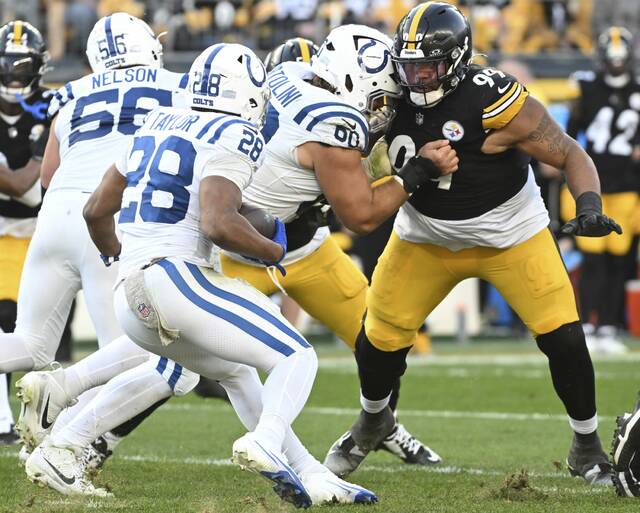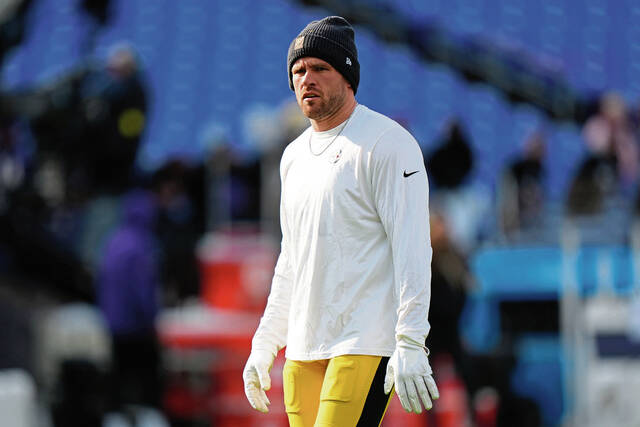In a way, I feel bad for the Pittsburgh Steelers offensive linemen.
In a few ways, actually.
For one, the fans and media were all so certain that the offensive line was the Steelers’ weakest link that it wasn’t until early November that the public stopped holding the unit responsible for everything that was going wrong with the team. And it wasn’t until after the bye that the group started to get credit for being, well, pretty decent, actually.
“Thinking back to standing out here in the preseason after a game (against the Jacksonville Jaguars) when the O-line was labeled as they were, I think the way they’ve come together and the job they’ve done. … You win up front. That’s the fact of life,” offensive coordinator Matt Canada said last week. “I think there’s a great credit to them for what they’ve done.”
The Steelers only allowed 38 sacks, good for a three-way tie for 13th fewest in the league — with a rookie quarterback in Kenny Pickett behind the line of scrimmage for most of the season. The team averaged 121.9 yards rushing per game. That was 16th in the NFL in 2022.
So, essentially, that’s in the middle of the league in both broad-based categories. Both numbers were significantly better over the second half of the season than the first. In fact, 27 of those sacks came over the first 10 games of the year. Just 11 occurred over the last seven weeks.
More sports
• Ahkello Witherspoon’s lost 2022 could mean he isn’t back with Steelers in 2023• Consistently inconsistent best way to sum up Penguins at midway point of season
• Steelers add 3 more to offseason roster, including former 4th-round pick RB Anthony McFarland
For the full year, Pro Football Focus rated the Steelers offensive line with a pass-blocking efficiency rating of 87.9, tied with the Baltimore Ravens for seventh best in the NFL. That rating measures pressure allowed on a per-snap basis (with weighting toward sacks allowed). They were a less impressive 18th in run blocking at 85.9 — although those numbers lump in blocking from receivers, tight ends, full backs, etc.
“If you take 15 minutes every day post-practice, by the end of the year, that’s hours of extra work you put in,” Steelers guard James Daniels said. “I think the guys did a really good job of trying to improve and doing the extra work.”
Yet, even when they were getting credit, it seemed like one explanation trumped all for why this previously presumed rag-tag group of blockers had suddenly become an above-average bunch.
Continuity.
That’s the word you always heard about the offensive line. The biggest reason why the offensive line was playing so well was continuity. The fact that all five starters — (from left to right) Dan Moore, Kevin Dotson, Mason Cole, Daniels, and Chuks Okorafor — all played between 96-100% of the team’s snaps.
It was almost like a default explanation for anything the offensive line did well.
“The most significant thing about the development of our offensive line is the availability of that group,” coach Mike Tomlin said at his season-ending press conference. “The continuity required to grow is a major component of it, and we’re thankful that not only do we have really good consistent in-game performance with that group, but just good practice ability and consistency in that area from that group. It starts first with availability and then the work.”
It was almost as if any conversation with coaches about the offensive line went like this:
“Hey, why did the O-Line win the ground game battle against the Ravens?”
Season-long continuity.
“How come they were able to outrush the Panthers by so much?”
Continuity. Oh, and Najee Harris is healthy now.
“How come Kenny Pickett’s sacks have dropped so much?”
Continuity. Oh, and Kenny is processing faster.
To an extent, it was almost like the continuity of the offensive line was being used as such a catch-all explanation for the group’s success, it was as if the players themselves weren’t getting proper credit for their individual improvement.
“We started to learn more of our playbook and learn the other processes of the plays instead of just our plays,” Dotson explained. “Not just knowing what we have to do. We have to know what the wide receivers, the tight ends, the quarterbacks, the running backs are thinking. I think we started to get that.”
At some point this offseason, conversations need to take place within the walls of the Steelers offices regarding big-picture opinions on the offensive linemen. In other words, what if this year is as good as it is going to get with this crew?
How good do they think that starting five unit really is? Was this just the start or is it the summit? How good is each member of the five individually? And if continuity is so important, can they really rely on all five people staying that healthy again next season?
The answer to that last question is a definitive “no.” There’s no way you are going to see all five linemen start all 17 games healthy for two straight years.
For example, even in a best-case scenario, look at the 2004 Pittsburgh Steelers. That team’s offensive line lost Kendall Simmons in training camp. Keydrick Vincent replaced him as the starter at right guard. Then, the starting unit had all five guys (Marvel Smith, Alan Faneca, Jeff Hartings, Vincent and Oliver Ross) start all 16 games. Simmons came back the next year, and four of the five started all 16 games again, but Smith missed four games along the way.
Perhaps it’s no coincidence that the Steelers went a combined 26-6 over those two years, made the AFC Championship game both times and won Super Bowl XL.
But even that four-leaf-clover bunch had at least one significant injury during the second year. How seriously do the Steelers attack O-Line depth in the draft or the free-agent market? After all, if continuity is king, if it gets dented, they may want high-end talent ready to go and step in for a stretch.
That’s why I wouldn’t rule out drafting or signing a starting-capable player somewhere along the offensive line, despite how well it played in the second half of the season. Maybe upgrade at one or two starting positions and make one or two of the solid starters backups.
It’d be risking continuity and chemistry in the name of potentially strengthening the depth and boosting the overall talent. But it may be worth it.
Especially at tackle.
The Steelers haven’t drafted a first-round tackle since Jamain Stephens in 1996. And they haven’t spent significant money to go out and land a plug-and-play free-agent starter at the position since Wayne Gandy in 1999.
That’s not a knock on Okorafor or Moore Jr. It’s just that Moore showed enough run-blocking acumen to suggest he may be able to bump inside at guard to battle with Dotson — or be the swing player between tackle and guard. And Okorafor is owed a total of $24.8 million against the salary cap over the next two seasons.
Or maybe just make a significant investment in young developmental depth.
Whatever the case, I don’t want the Steelers to go into 2023 with the attitude of, “Meh, the offensive line can wait now. They got good enough by November of last year. It’ll be fine. Let’s address everything else first.”
After all, that’d be ignoring their own logic of how fortunate they were to have the continuity they’ve been heralding in the first place.
This O-line was surprisingly adequate in 2022. I can see the potential for it to be very good in 2023 with a few smart additions.
Tim Benz does an “exit interview” with Steelers offensive lineman James Daniels as the team wraps up its 2022 season.









